TAE40116 Assessment 5: Develop Training and Assessment for SIRXWHS001
VerifiedAdded on 2024/07/22
|45
|11062
|64
Practical Assignment
AI Summary
This assignment details a comprehensive training and assessment plan developed for Smart Learning RTO, focusing on the Certificate II qualification with the inclusion of the unit of competency SIRXWHS001, 'Work Safely'. It includes packaging the qualification, planning the unit of competency with consideration of stakeholder needs, and creating session plans for two consecutive 40-minute training sessions. The plan covers various aspects such as risk management, legal and ethical considerations, learner characteristics, contextualization, and the application of adult learning theories. It further involves the development of an assessment tool to evaluate competence in the unit, ensuring that training and assessment are aligned with client needs and RTO standards. The training sessions focus on implementing appropriate practices to ensure workplace safety and adapting experiences to meet individual employee routines. The assessment is designed to evaluate the performance criteria covered in the training sessions.
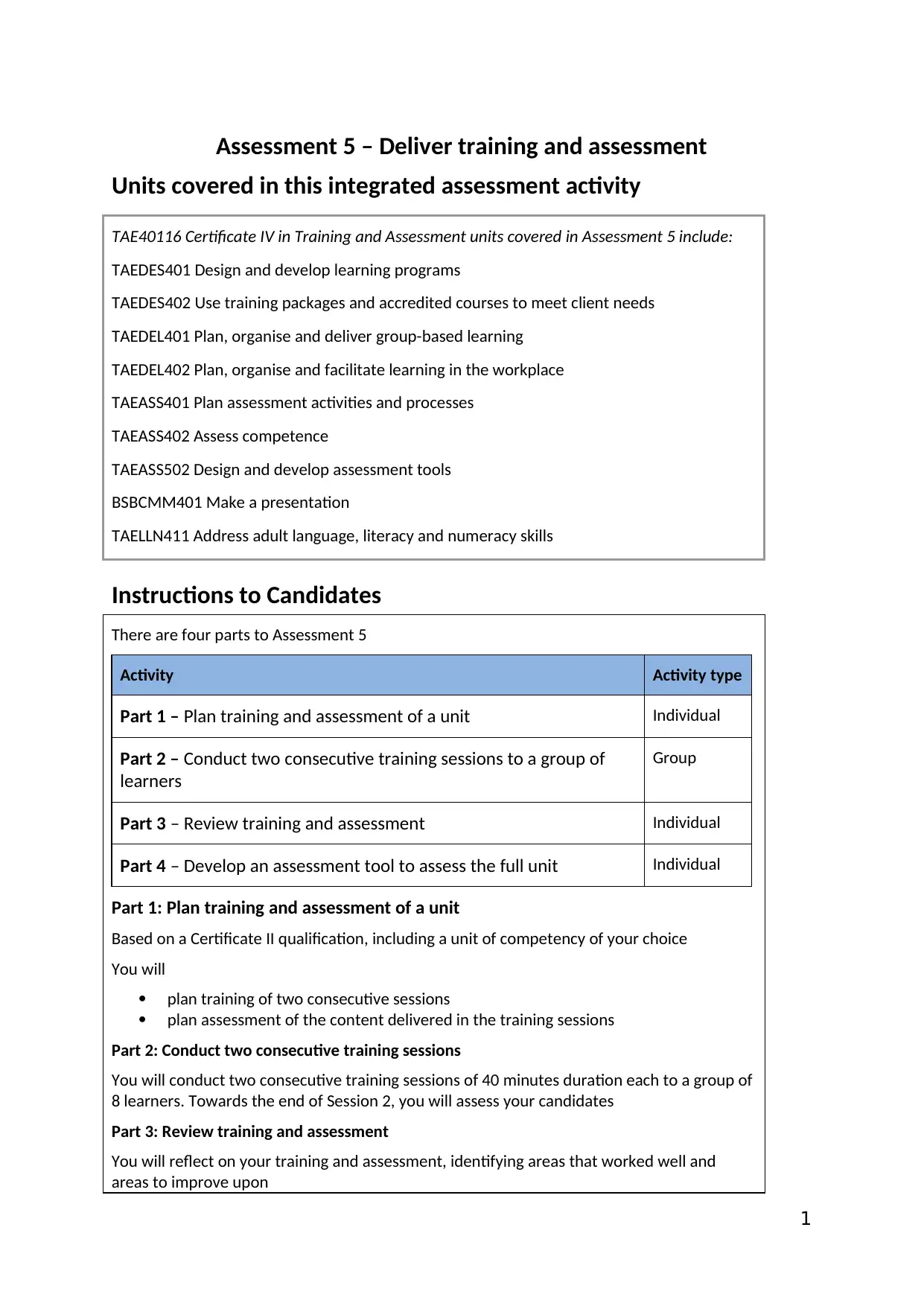
Assessment 5 – Deliver training and assessment
Units covered in this integrated assessment activity
TAE40116 Certificate IV in Training and Assessment units covered in Assessment 5 include:
TAEDES401 Design and develop learning programs
TAEDES402 Use training packages and accredited courses to meet client needs
TAEDEL401 Plan, organise and deliver group-based learning
TAEDEL402 Plan, organise and facilitate learning in the workplace
TAEASS401 Plan assessment activities and processes
TAEASS402 Assess competence
TAEASS502 Design and develop assessment tools
BSBCMM401 Make a presentation
TAELLN411 Address adult language, literacy and numeracy skills
Instructions to Candidates
There are four parts to Assessment 5
Activity Activity type
Part 1 – Plan training and assessment of a unit Individual
Part 2 – Conduct two consecutive training sessions to a group of
learners
Group
Part 3 – Review training and assessment Individual
Part 4 – Develop an assessment tool to assess the full unit Individual
Part 1: Plan training and assessment of a unit
Based on a Certificate II qualification, including a unit of competency of your choice
You will
plan training of two consecutive sessions
plan assessment of the content delivered in the training sessions
Part 2: Conduct two consecutive training sessions
You will conduct two consecutive training sessions of 40 minutes duration each to a group of
8 learners. Towards the end of Session 2, you will assess your candidates
Part 3: Review training and assessment
You will reflect on your training and assessment, identifying areas that worked well and
areas to improve upon
1
Units covered in this integrated assessment activity
TAE40116 Certificate IV in Training and Assessment units covered in Assessment 5 include:
TAEDES401 Design and develop learning programs
TAEDES402 Use training packages and accredited courses to meet client needs
TAEDEL401 Plan, organise and deliver group-based learning
TAEDEL402 Plan, organise and facilitate learning in the workplace
TAEASS401 Plan assessment activities and processes
TAEASS402 Assess competence
TAEASS502 Design and develop assessment tools
BSBCMM401 Make a presentation
TAELLN411 Address adult language, literacy and numeracy skills
Instructions to Candidates
There are four parts to Assessment 5
Activity Activity type
Part 1 – Plan training and assessment of a unit Individual
Part 2 – Conduct two consecutive training sessions to a group of
learners
Group
Part 3 – Review training and assessment Individual
Part 4 – Develop an assessment tool to assess the full unit Individual
Part 1: Plan training and assessment of a unit
Based on a Certificate II qualification, including a unit of competency of your choice
You will
plan training of two consecutive sessions
plan assessment of the content delivered in the training sessions
Part 2: Conduct two consecutive training sessions
You will conduct two consecutive training sessions of 40 minutes duration each to a group of
8 learners. Towards the end of Session 2, you will assess your candidates
Part 3: Review training and assessment
You will reflect on your training and assessment, identifying areas that worked well and
areas to improve upon
1
Paraphrase This Document
Need a fresh take? Get an instant paraphrase of this document with our AI Paraphraser
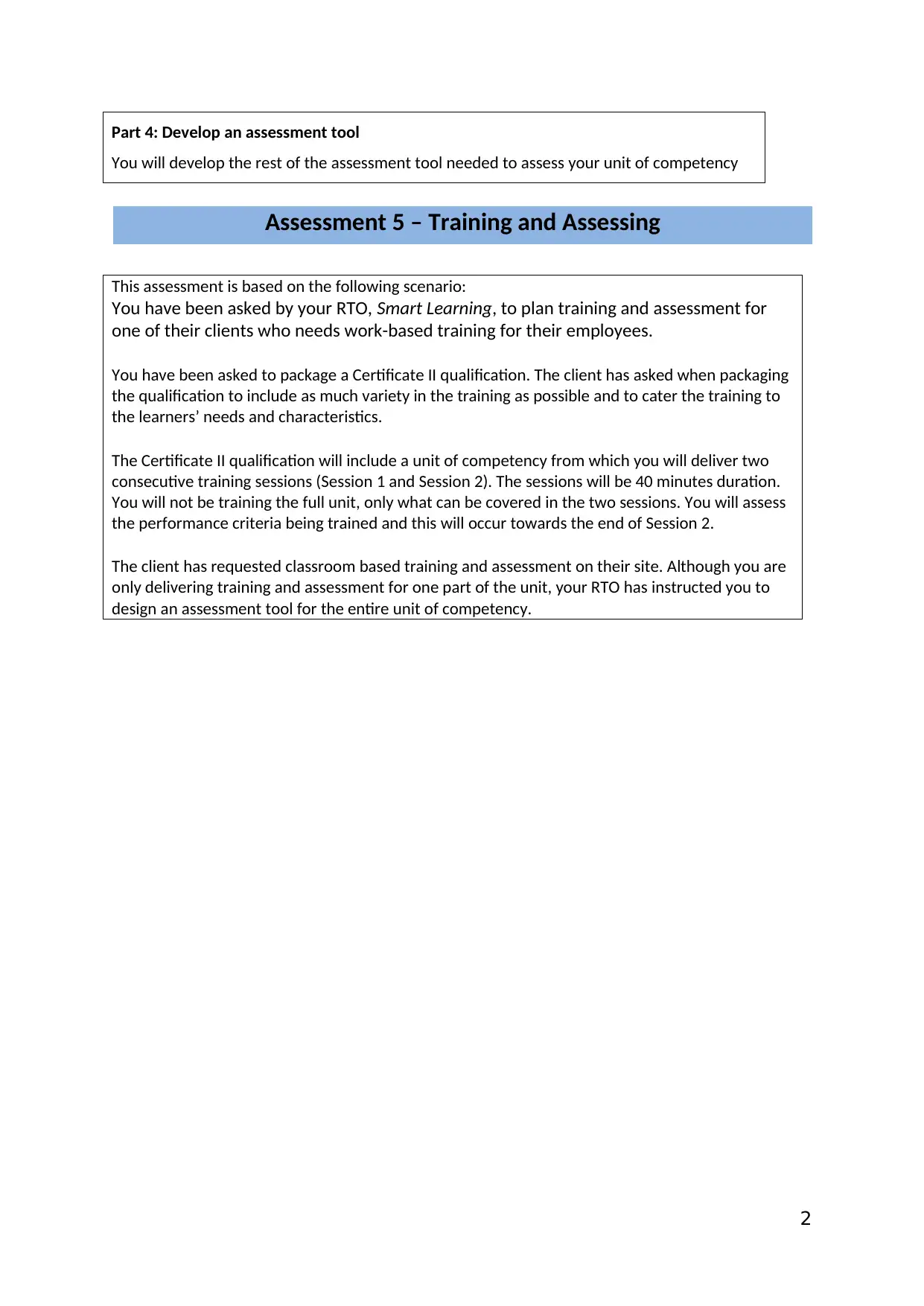
Part 4: Develop an assessment tool
You will develop the rest of the assessment tool needed to assess your unit of competency
This assessment is based on the following scenario:
You have been asked by your RTO, Smart Learning, to plan training and assessment for
one of their clients who needs work-based training for their employees.
You have been asked to package a Certificate II qualification. The client has asked when packaging
the qualification to include as much variety in the training as possible and to cater the training to
the learners’ needs and characteristics.
The Certificate II qualification will include a unit of competency from which you will deliver two
consecutive training sessions (Session 1 and Session 2). The sessions will be 40 minutes duration.
You will not be training the full unit, only what can be covered in the two sessions. You will assess
the performance criteria being trained and this will occur towards the end of Session 2.
The client has requested classroom based training and assessment on their site. Although you are
only delivering training and assessment for one part of the unit, your RTO has instructed you to
design an assessment tool for the entire unit of competency.
2
Assessment 5 – Training and Assessing
You will develop the rest of the assessment tool needed to assess your unit of competency
This assessment is based on the following scenario:
You have been asked by your RTO, Smart Learning, to plan training and assessment for
one of their clients who needs work-based training for their employees.
You have been asked to package a Certificate II qualification. The client has asked when packaging
the qualification to include as much variety in the training as possible and to cater the training to
the learners’ needs and characteristics.
The Certificate II qualification will include a unit of competency from which you will deliver two
consecutive training sessions (Session 1 and Session 2). The sessions will be 40 minutes duration.
You will not be training the full unit, only what can be covered in the two sessions. You will assess
the performance criteria being trained and this will occur towards the end of Session 2.
The client has requested classroom based training and assessment on their site. Although you are
only delivering training and assessment for one part of the unit, your RTO has instructed you to
design an assessment tool for the entire unit of competency.
2
Assessment 5 – Training and Assessing
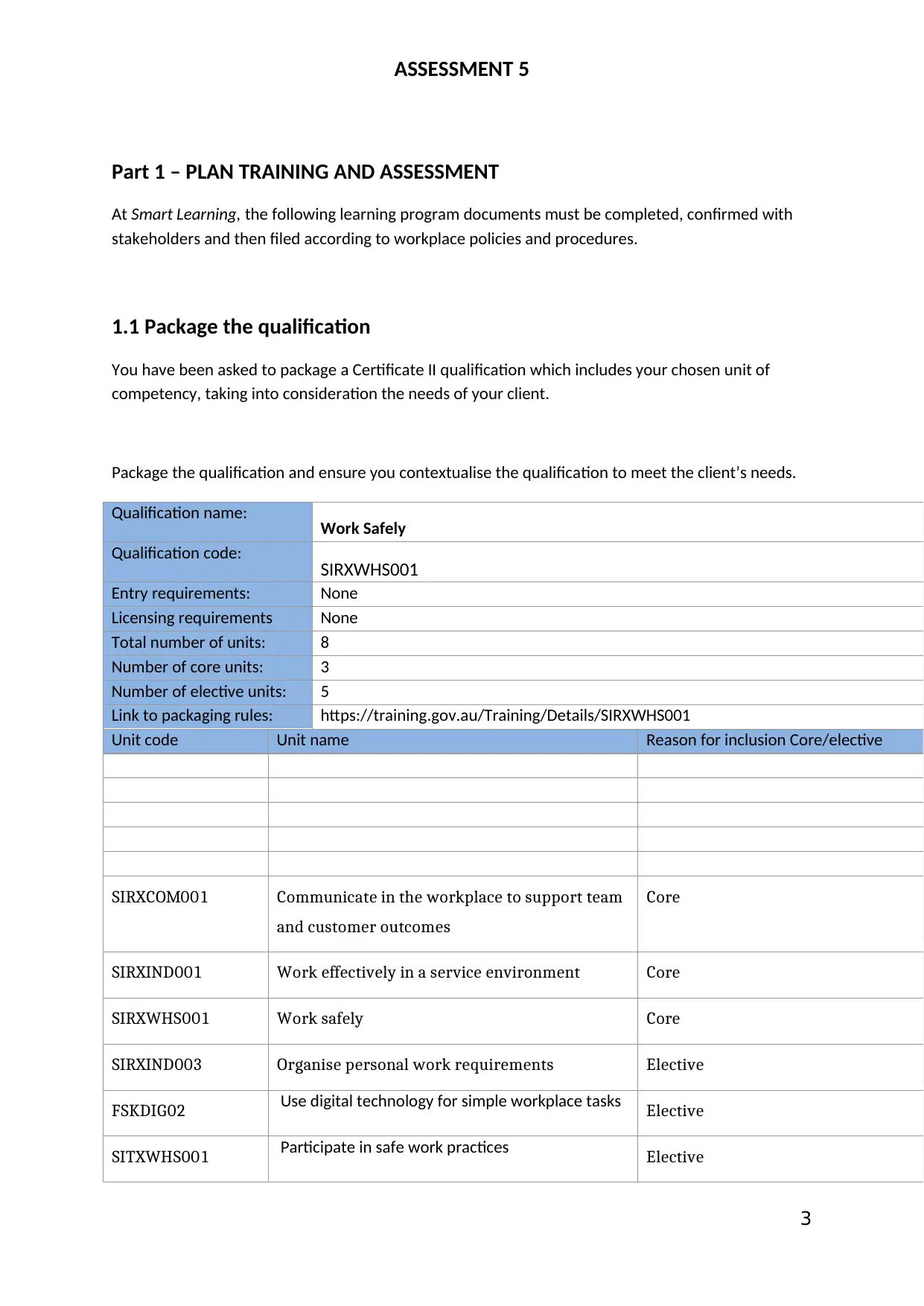
ASSESSMENT 5
Part 1 – PLAN TRAINING AND ASSESSMENT
At Smart Learning, the following learning program documents must be completed, confirmed with
stakeholders and then filed according to workplace policies and procedures.
1.1 Package the qualification
You have been asked to package a Certificate II qualification which includes your chosen unit of
competency, taking into consideration the needs of your client.
Package the qualification and ensure you contextualise the qualification to meet the client’s needs.
Qualification name: Work Safely
Qualification code: SIRXWHS001
Entry requirements: None
Licensing requirements None
Total number of units: 8
Number of core units: 3
Number of elective units: 5
Link to packaging rules: https://training.gov.au/Training/Details/SIRXWHS001
Unit code Unit name Reason for inclusion Core/elective
SIRXCOM001 Communicate in the workplace to support team
and customer outcomes
Core
SIRXIND001 Work effectively in a service environment Core
SIRXWHS001 Work safely Core
SIRXIND003 Organise personal work requirements Elective
FSKDIG02 Use digital technology for simple workplace tasks Elective
SITXWHS001 Participate in safe work practices Elective
3
Part 1 – PLAN TRAINING AND ASSESSMENT
At Smart Learning, the following learning program documents must be completed, confirmed with
stakeholders and then filed according to workplace policies and procedures.
1.1 Package the qualification
You have been asked to package a Certificate II qualification which includes your chosen unit of
competency, taking into consideration the needs of your client.
Package the qualification and ensure you contextualise the qualification to meet the client’s needs.
Qualification name: Work Safely
Qualification code: SIRXWHS001
Entry requirements: None
Licensing requirements None
Total number of units: 8
Number of core units: 3
Number of elective units: 5
Link to packaging rules: https://training.gov.au/Training/Details/SIRXWHS001
Unit code Unit name Reason for inclusion Core/elective
SIRXCOM001 Communicate in the workplace to support team
and customer outcomes
Core
SIRXIND001 Work effectively in a service environment Core
SIRXWHS001 Work safely Core
SIRXIND003 Organise personal work requirements Elective
FSKDIG02 Use digital technology for simple workplace tasks Elective
SITXWHS001 Participate in safe work practices Elective
3
⊘ This is a preview!⊘
Do you want full access?
Subscribe today to unlock all pages.

Trusted by 1+ million students worldwide
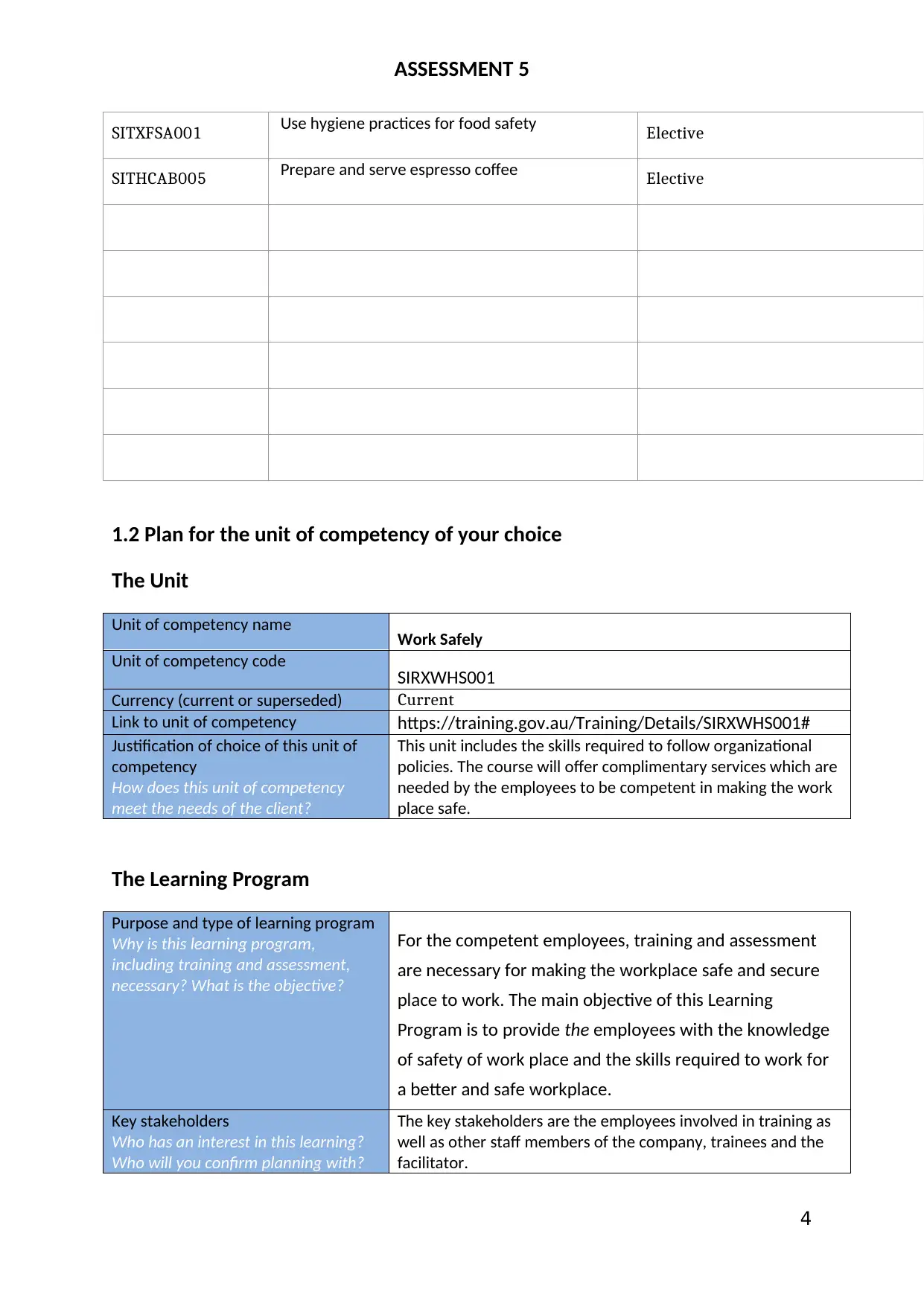
ASSESSMENT 5
SITXFSA001 Use hygiene practices for food safety Elective
SITHCAB005 Prepare and serve espresso coffee Elective
1.2 Plan for the unit of competency of your choice
The Unit
Unit of competency name Work Safely
Unit of competency code SIRXWHS001
Currency (current or superseded) Current
Link to unit of competency https://training.gov.au/Training/Details/SIRXWHS001#
Justification of choice of this unit of
competency
How does this unit of competency
meet the needs of the client?
This unit includes the skills required to follow organizational
policies. The course will offer complimentary services which are
needed by the employees to be competent in making the work
place safe.
The Learning Program
Purpose and type of learning program
Why is this learning program,
including training and assessment,
necessary? What is the objective?
For the competent employees, training and assessment
are necessary for making the workplace safe and secure
place to work. The main objective of this Learning
Program is to provide the employees with the knowledge
of safety of work place and the skills required to work for
a better and safe workplace.
Key stakeholders
Who has an interest in this learning?
Who will you confirm planning with?
The key stakeholders are the employees involved in training as
well as other staff members of the company, trainees and the
facilitator.
4
SITXFSA001 Use hygiene practices for food safety Elective
SITHCAB005 Prepare and serve espresso coffee Elective
1.2 Plan for the unit of competency of your choice
The Unit
Unit of competency name Work Safely
Unit of competency code SIRXWHS001
Currency (current or superseded) Current
Link to unit of competency https://training.gov.au/Training/Details/SIRXWHS001#
Justification of choice of this unit of
competency
How does this unit of competency
meet the needs of the client?
This unit includes the skills required to follow organizational
policies. The course will offer complimentary services which are
needed by the employees to be competent in making the work
place safe.
The Learning Program
Purpose and type of learning program
Why is this learning program,
including training and assessment,
necessary? What is the objective?
For the competent employees, training and assessment
are necessary for making the workplace safe and secure
place to work. The main objective of this Learning
Program is to provide the employees with the knowledge
of safety of work place and the skills required to work for
a better and safe workplace.
Key stakeholders
Who has an interest in this learning?
Who will you confirm planning with?
The key stakeholders are the employees involved in training as
well as other staff members of the company, trainees and the
facilitator.
4
Paraphrase This Document
Need a fresh take? Get an instant paraphrase of this document with our AI Paraphraser
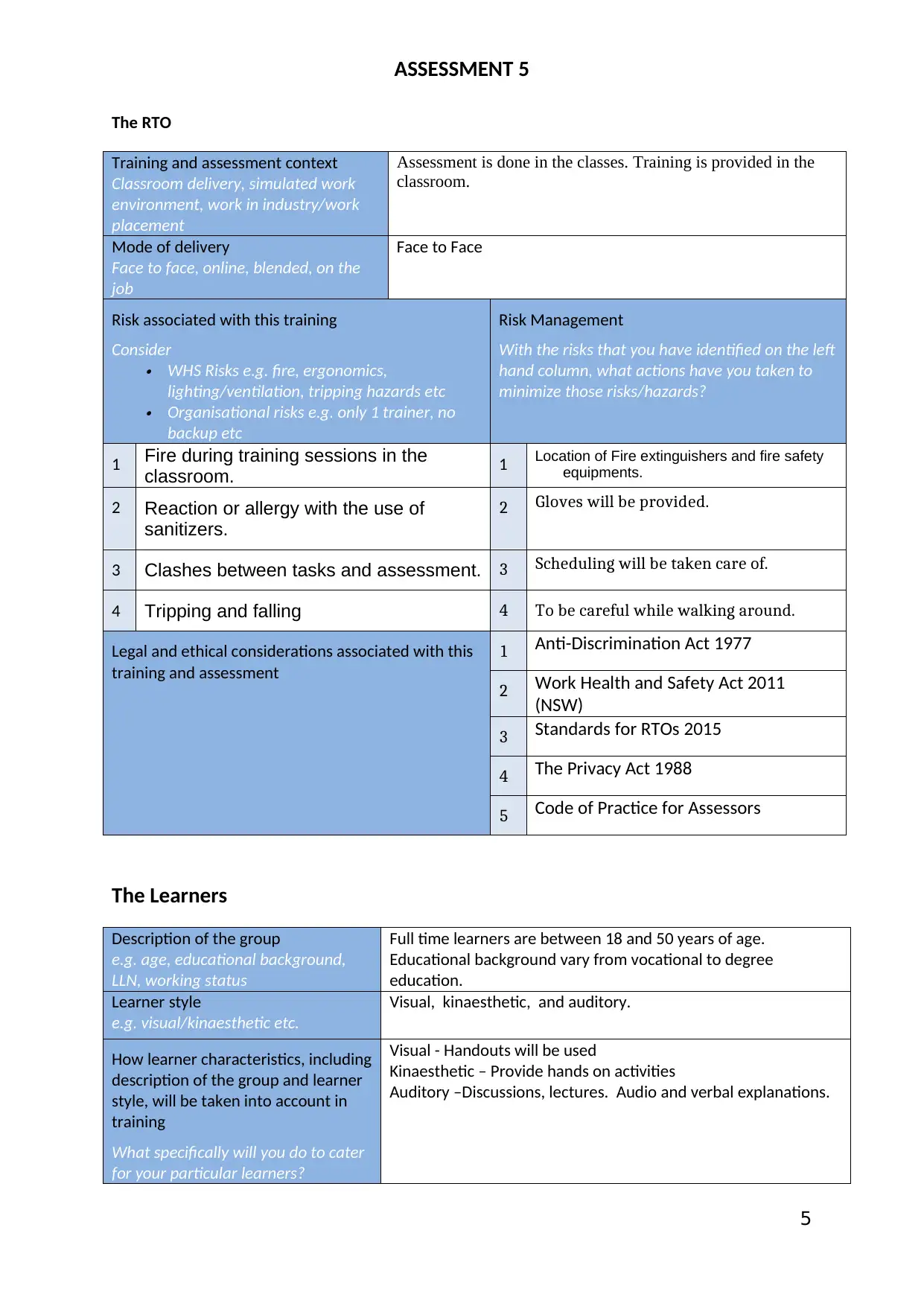
ASSESSMENT 5
The RTO
Training and assessment context
Classroom delivery, simulated work
environment, work in industry/work
placement
Assessment is done in the classes. Training is provided in the
classroom.
Mode of delivery
Face to face, online, blended, on the
job
Face to Face
Risk associated with this training
Consider
WHS Risks e.g. fire, ergonomics,
lighting/ventilation, tripping hazards etc
Organisational risks e.g. only 1 trainer, no
backup etc
Risk Management
With the risks that you have identified on the left
hand column, what actions have you taken to
minimize those risks/hazards?
1 Fire during training sessions in the
classroom. 1 Location of Fire extinguishers and fire safety
equipments.
2 Reaction or allergy with the use of
sanitizers.
2 Gloves will be provided.
3 Clashes between tasks and assessment. 3 Scheduling will be taken care of.
4 Tripping and falling 4 To be careful while walking around.
Legal and ethical considerations associated with this
training and assessment
1 Anti-Discrimination Act 1977
2 Work Health and Safety Act 2011
(NSW)
3 Standards for RTOs 2015
4 The Privacy Act 1988
5 Code of Practice for Assessors
The Learners
Description of the group
e.g. age, educational background,
LLN, working status
Full time learners are between 18 and 50 years of age.
Educational background vary from vocational to degree
education.
Learner style
e.g. visual/kinaesthetic etc.
Visual, kinaesthetic, and auditory.
How learner characteristics, including
description of the group and learner
style, will be taken into account in
training
What specifically will you do to cater
for your particular learners?
Visual - Handouts will be used
Kinaesthetic – Provide hands on activities
Auditory –Discussions, lectures. Audio and verbal explanations.
5
The RTO
Training and assessment context
Classroom delivery, simulated work
environment, work in industry/work
placement
Assessment is done in the classes. Training is provided in the
classroom.
Mode of delivery
Face to face, online, blended, on the
job
Face to Face
Risk associated with this training
Consider
WHS Risks e.g. fire, ergonomics,
lighting/ventilation, tripping hazards etc
Organisational risks e.g. only 1 trainer, no
backup etc
Risk Management
With the risks that you have identified on the left
hand column, what actions have you taken to
minimize those risks/hazards?
1 Fire during training sessions in the
classroom. 1 Location of Fire extinguishers and fire safety
equipments.
2 Reaction or allergy with the use of
sanitizers.
2 Gloves will be provided.
3 Clashes between tasks and assessment. 3 Scheduling will be taken care of.
4 Tripping and falling 4 To be careful while walking around.
Legal and ethical considerations associated with this
training and assessment
1 Anti-Discrimination Act 1977
2 Work Health and Safety Act 2011
(NSW)
3 Standards for RTOs 2015
4 The Privacy Act 1988
5 Code of Practice for Assessors
The Learners
Description of the group
e.g. age, educational background,
LLN, working status
Full time learners are between 18 and 50 years of age.
Educational background vary from vocational to degree
education.
Learner style
e.g. visual/kinaesthetic etc.
Visual, kinaesthetic, and auditory.
How learner characteristics, including
description of the group and learner
style, will be taken into account in
training
What specifically will you do to cater
for your particular learners?
Visual - Handouts will be used
Kinaesthetic – Provide hands on activities
Auditory –Discussions, lectures. Audio and verbal explanations.
5
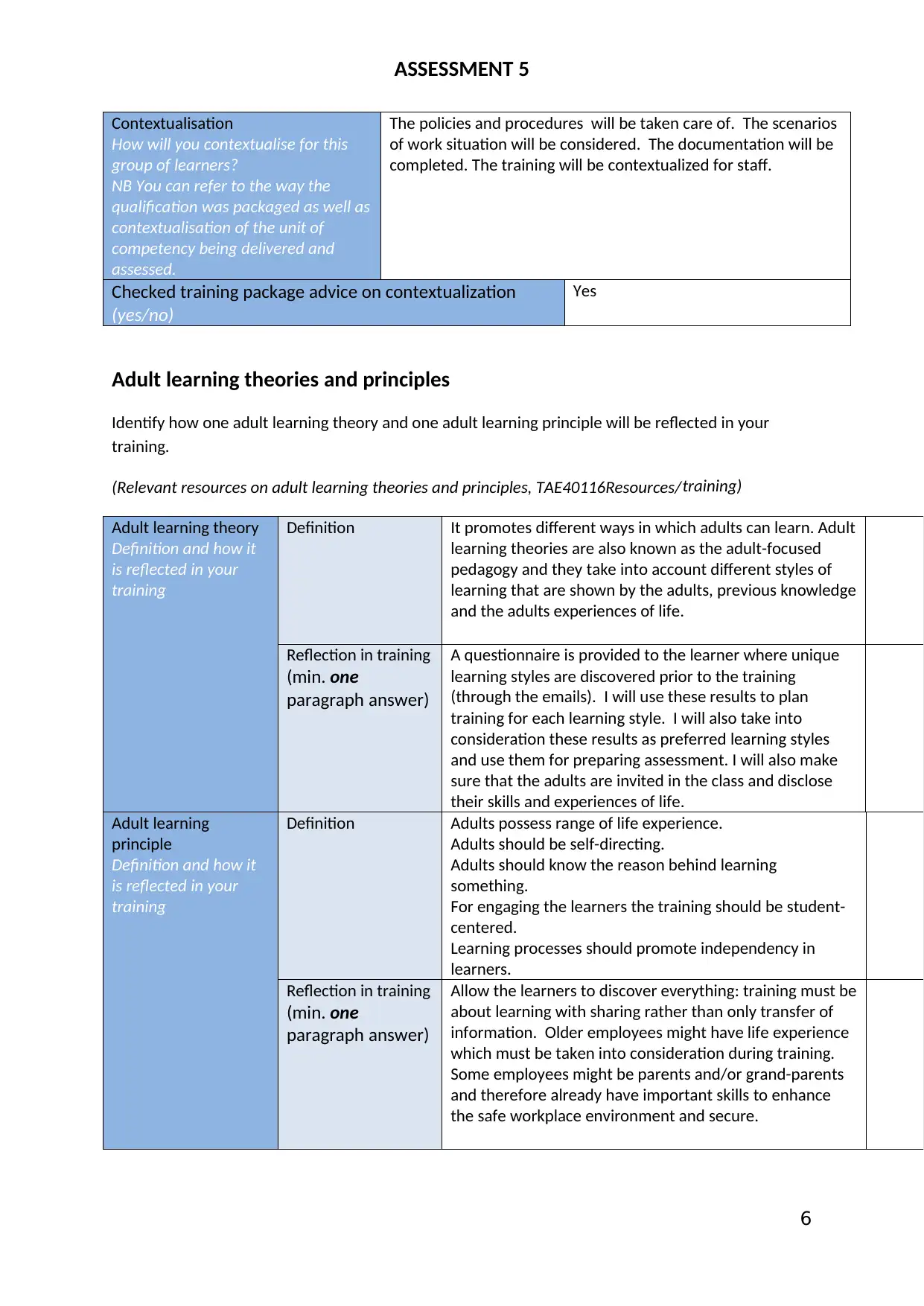
ASSESSMENT 5
Contextualisation
How will you contextualise for this
group of learners?
NB You can refer to the way the
qualification was packaged as well as
contextualisation of the unit of
competency being delivered and
assessed.
The policies and procedures will be taken care of. The scenarios
of work situation will be considered. The documentation will be
completed. The training will be contextualized for staff.
Checked training package advice on contextualization
(yes/no)
Yes
Adult learning theories and principles
Identify how one adult learning theory and one adult learning principle will be reflected in your
training.
(Relevant resources on adult learning theories and principles, TAE40116Resources/training)
Adult learning theory
Definition and how it
is reflected in your
training
Definition It promotes different ways in which adults can learn. Adult
learning theories are also known as the adult-focused
pedagogy and they take into account different styles of
learning that are shown by the adults, previous knowledge
and the adults experiences of life.
Reflection in training
(min. one
paragraph answer)
A questionnaire is provided to the learner where unique
learning styles are discovered prior to the training
(through the emails). I will use these results to plan
training for each learning style. I will also take into
consideration these results as preferred learning styles
and use them for preparing assessment. I will also make
sure that the adults are invited in the class and disclose
their skills and experiences of life.
Adult learning
principle
Definition and how it
is reflected in your
training
Definition Adults possess range of life experience.
Adults should be self-directing.
Adults should know the reason behind learning
something.
For engaging the learners the training should be student-
centered.
Learning processes should promote independency in
learners.
Reflection in training
(min. one
paragraph answer)
Allow the learners to discover everything: training must be
about learning with sharing rather than only transfer of
information. Older employees might have life experience
which must be taken into consideration during training.
Some employees might be parents and/or grand-parents
and therefore already have important skills to enhance
the safe workplace environment and secure.
6
Contextualisation
How will you contextualise for this
group of learners?
NB You can refer to the way the
qualification was packaged as well as
contextualisation of the unit of
competency being delivered and
assessed.
The policies and procedures will be taken care of. The scenarios
of work situation will be considered. The documentation will be
completed. The training will be contextualized for staff.
Checked training package advice on contextualization
(yes/no)
Yes
Adult learning theories and principles
Identify how one adult learning theory and one adult learning principle will be reflected in your
training.
(Relevant resources on adult learning theories and principles, TAE40116Resources/training)
Adult learning theory
Definition and how it
is reflected in your
training
Definition It promotes different ways in which adults can learn. Adult
learning theories are also known as the adult-focused
pedagogy and they take into account different styles of
learning that are shown by the adults, previous knowledge
and the adults experiences of life.
Reflection in training
(min. one
paragraph answer)
A questionnaire is provided to the learner where unique
learning styles are discovered prior to the training
(through the emails). I will use these results to plan
training for each learning style. I will also take into
consideration these results as preferred learning styles
and use them for preparing assessment. I will also make
sure that the adults are invited in the class and disclose
their skills and experiences of life.
Adult learning
principle
Definition and how it
is reflected in your
training
Definition Adults possess range of life experience.
Adults should be self-directing.
Adults should know the reason behind learning
something.
For engaging the learners the training should be student-
centered.
Learning processes should promote independency in
learners.
Reflection in training
(min. one
paragraph answer)
Allow the learners to discover everything: training must be
about learning with sharing rather than only transfer of
information. Older employees might have life experience
which must be taken into consideration during training.
Some employees might be parents and/or grand-parents
and therefore already have important skills to enhance
the safe workplace environment and secure.
6
⊘ This is a preview!⊘
Do you want full access?
Subscribe today to unlock all pages.

Trusted by 1+ million students worldwide

ASSESSMENT 5
7
7
Paraphrase This Document
Need a fresh take? Get an instant paraphrase of this document with our AI Paraphraser
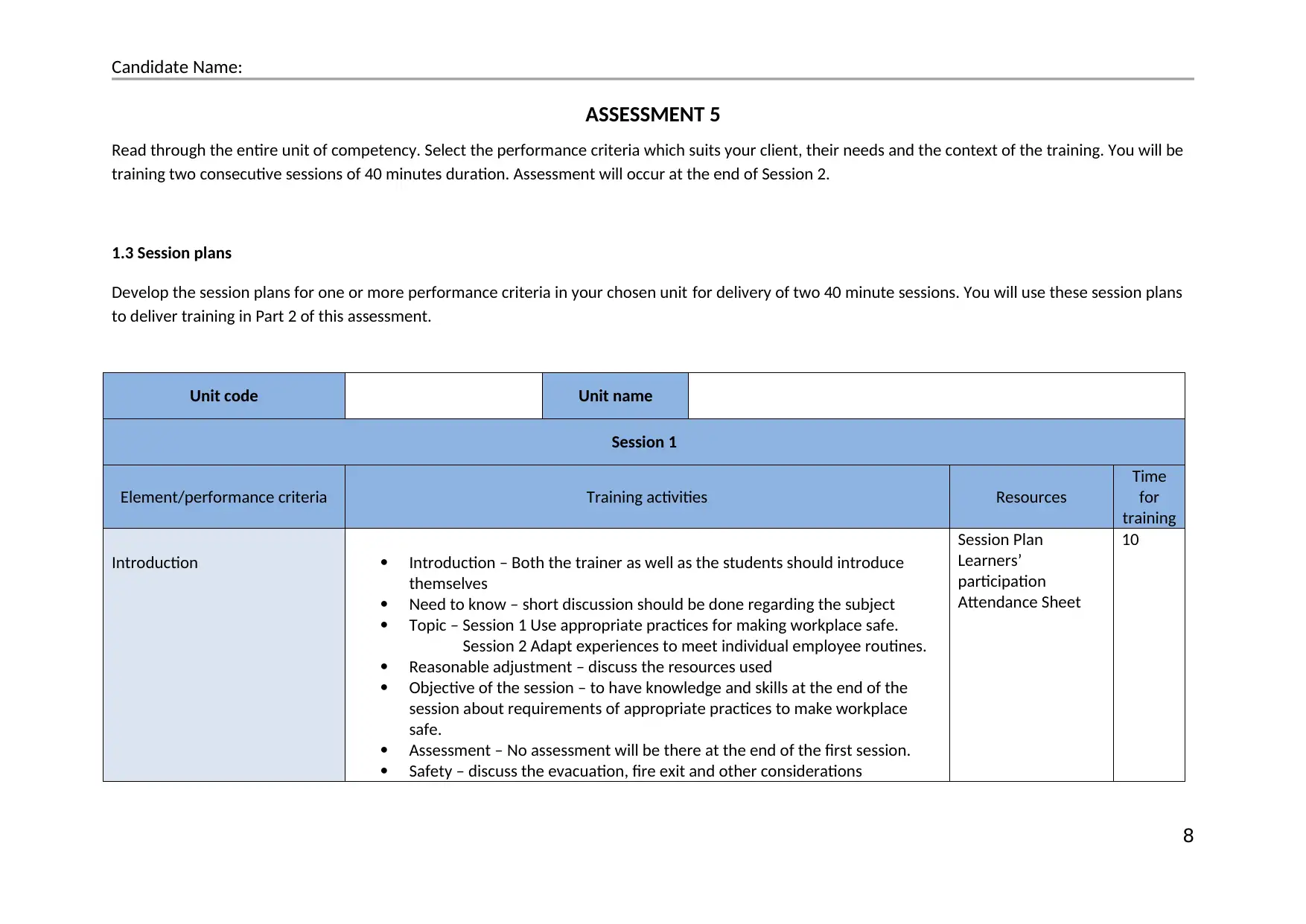
Candidate Name:
ASSESSMENT 5
Read through the entire unit of competency. Select the performance criteria which suits your client, their needs and the context of the training. You will be
training two consecutive sessions of 40 minutes duration. Assessment will occur at the end of Session 2.
1.3 Session plans
Develop the session plans for one or more performance criteria in your chosen unit for delivery of two 40 minute sessions. You will use these session plans
to deliver training in Part 2 of this assessment.
Unit code Unit name
Session 1
Element/performance criteria Training activities Resources
Time
for
training
Introduction Introduction – Both the trainer as well as the students should introduce
themselves
Need to know – short discussion should be done regarding the subject
Topic – Session 1 Use appropriate practices for making workplace safe.
Session 2 Adapt experiences to meet individual employee routines.
Reasonable adjustment – discuss the resources used
Objective of the session – to have knowledge and skills at the end of the
session about requirements of appropriate practices to make workplace
safe.
Assessment – No assessment will be there at the end of the first session.
Safety – discuss the evacuation, fire exit and other considerations
Session Plan
Learners’
participation
Attendance Sheet
10
8
ASSESSMENT 5
Read through the entire unit of competency. Select the performance criteria which suits your client, their needs and the context of the training. You will be
training two consecutive sessions of 40 minutes duration. Assessment will occur at the end of Session 2.
1.3 Session plans
Develop the session plans for one or more performance criteria in your chosen unit for delivery of two 40 minute sessions. You will use these session plans
to deliver training in Part 2 of this assessment.
Unit code Unit name
Session 1
Element/performance criteria Training activities Resources
Time
for
training
Introduction Introduction – Both the trainer as well as the students should introduce
themselves
Need to know – short discussion should be done regarding the subject
Topic – Session 1 Use appropriate practices for making workplace safe.
Session 2 Adapt experiences to meet individual employee routines.
Reasonable adjustment – discuss the resources used
Objective of the session – to have knowledge and skills at the end of the
session about requirements of appropriate practices to make workplace
safe.
Assessment – No assessment will be there at the end of the first session.
Safety – discuss the evacuation, fire exit and other considerations
Session Plan
Learners’
participation
Attendance Sheet
10
8
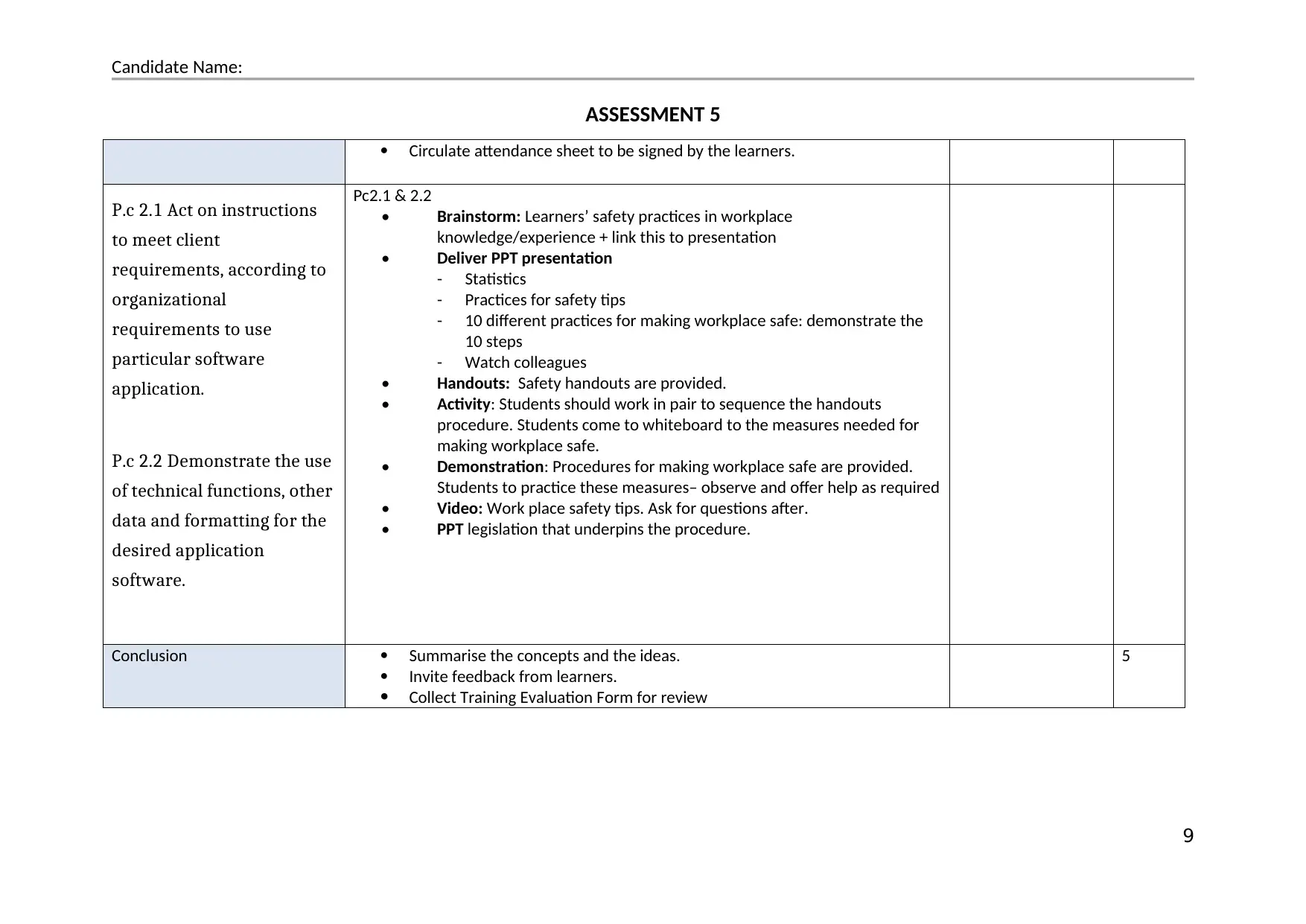
Candidate Name:
ASSESSMENT 5
Circulate attendance sheet to be signed by the learners.
P.c 2.1 Act on instructions
to meet client
requirements, according to
organizational
requirements to use
particular software
application.
P.c 2.2 Demonstrate the use
of technical functions, other
data and formatting for the
desired application
software.
Pc2.1 & 2.2
• Brainstorm: Learners’ safety practices in workplace
knowledge/experience + link this to presentation
• Deliver PPT presentation
- Statistics
- Practices for safety tips
- 10 different practices for making workplace safe: demonstrate the
10 steps
- Watch colleagues
• Handouts: Safety handouts are provided.
• Activity: Students should work in pair to sequence the handouts
procedure. Students come to whiteboard to the measures needed for
making workplace safe.
• Demonstration: Procedures for making workplace safe are provided.
Students to practice these measures– observe and offer help as required
• Video: Work place safety tips. Ask for questions after.
• PPT legislation that underpins the procedure.
Conclusion Summarise the concepts and the ideas.
Invite feedback from learners.
Collect Training Evaluation Form for review
5
9
ASSESSMENT 5
Circulate attendance sheet to be signed by the learners.
P.c 2.1 Act on instructions
to meet client
requirements, according to
organizational
requirements to use
particular software
application.
P.c 2.2 Demonstrate the use
of technical functions, other
data and formatting for the
desired application
software.
Pc2.1 & 2.2
• Brainstorm: Learners’ safety practices in workplace
knowledge/experience + link this to presentation
• Deliver PPT presentation
- Statistics
- Practices for safety tips
- 10 different practices for making workplace safe: demonstrate the
10 steps
- Watch colleagues
• Handouts: Safety handouts are provided.
• Activity: Students should work in pair to sequence the handouts
procedure. Students come to whiteboard to the measures needed for
making workplace safe.
• Demonstration: Procedures for making workplace safe are provided.
Students to practice these measures– observe and offer help as required
• Video: Work place safety tips. Ask for questions after.
• PPT legislation that underpins the procedure.
Conclusion Summarise the concepts and the ideas.
Invite feedback from learners.
Collect Training Evaluation Form for review
5
9
⊘ This is a preview!⊘
Do you want full access?
Subscribe today to unlock all pages.

Trusted by 1+ million students worldwide

Candidate Name:
ASSESSMENT 5
Session 2
PC/element Training activities Resources
Time
for
training
Introduction
Introduction – Both the trainer as well as the students should introduce
themselves
Need to know – short discussion should be done regarding the subject
Topic – Adapt experiences to meet individual employee routines.
Reasonable adjustment – discuss the resources used
Objective of the session 2– to have knowledge and skills at the end of the
session about requirements of appropriate practices to make workplace
safe.
Assessment of session 2 – One written and practical assessment will be
done for the second session.
Circulate attendance sheet to be signed by the learners.
P.c.2.3 Open, amend and
save files and documents
according to organisational
requirements.
P.c 2.4 Identify operating
system and components.
Pc2.1 & 2.2
• Delivering PPT presentation
- Recap Session 1 and distribute handouts with pictures about
procedure
- Describe objectives of Session 2
- Discuss common challenges
- Explain how to make workplace safe and secure.
- Pass around selected sensory resources that stimulate senses for
students to explore
- Brainstorm what else could be done for making the workplaces safe.
- Practices for safety tips
• Activity: Scenario 1 and 2 should be brainstormed.
10
ASSESSMENT 5
Session 2
PC/element Training activities Resources
Time
for
training
Introduction
Introduction – Both the trainer as well as the students should introduce
themselves
Need to know – short discussion should be done regarding the subject
Topic – Adapt experiences to meet individual employee routines.
Reasonable adjustment – discuss the resources used
Objective of the session 2– to have knowledge and skills at the end of the
session about requirements of appropriate practices to make workplace
safe.
Assessment of session 2 – One written and practical assessment will be
done for the second session.
Circulate attendance sheet to be signed by the learners.
P.c.2.3 Open, amend and
save files and documents
according to organisational
requirements.
P.c 2.4 Identify operating
system and components.
Pc2.1 & 2.2
• Delivering PPT presentation
- Recap Session 1 and distribute handouts with pictures about
procedure
- Describe objectives of Session 2
- Discuss common challenges
- Explain how to make workplace safe and secure.
- Pass around selected sensory resources that stimulate senses for
students to explore
- Brainstorm what else could be done for making the workplaces safe.
- Practices for safety tips
• Activity: Scenario 1 and 2 should be brainstormed.
10
Paraphrase This Document
Need a fresh take? Get an instant paraphrase of this document with our AI Paraphraser

Candidate Name:
ASSESSMENT 5
• Demonstration: Procedures for making workplace safe are provided.
Students to practice these measures– observe and offer help as required
• Video: Work place safety tips. Ask for questions after.
• PPT legislation that underpins the procedure.
Conclusion Summarize the concepts and the ideas.
Invite feedback from learners.
Collect Training Evaluation Form for review
Assessment Written and practical assessment done.
11
ASSESSMENT 5
• Demonstration: Procedures for making workplace safe are provided.
Students to practice these measures– observe and offer help as required
• Video: Work place safety tips. Ask for questions after.
• PPT legislation that underpins the procedure.
Conclusion Summarize the concepts and the ideas.
Invite feedback from learners.
Collect Training Evaluation Form for review
Assessment Written and practical assessment done.
11

Candidate Name:
ASSESSMENT 5
Plan assessment
Read and analyse the assessment requirements of your unit of competency. Develop the plan for assessing the performance criteria being trained in your
two training sessions. Plan for assessment to occur once, at the end of Session 2.
1.4 Assessment method
Provide advise to the client regarding your choice of assessment.
Element Performance criteria Assessment method Assessment instrument
Provide different methods of
keeping the workplace safe
and secure.
Use appropriate practices for making workplace
safe.
Adapt experiences to meet individual employee
routines
Direct observation Practical task.
Written assessment Quiz
What is the reason for your choice of assessment method/s? Ensure you make reference to the PC being assessed and the context of the assessment. Think
about what aspect of the PC is being assessed by the method/s you have chosen.
I chose written assessment and the direct observation for the practical task as
assessment methods. Students demonstrate both their skills and knowledge in
following the procedures and methods to keep the workplace safe and secure.
For Pc 2.2 Adapt experiences to meet the individual child’s routines I have chosen a
written assessment only.
What is an alternative assessment method/instrument to the recommended choice?
12
ASSESSMENT 5
Plan assessment
Read and analyse the assessment requirements of your unit of competency. Develop the plan for assessing the performance criteria being trained in your
two training sessions. Plan for assessment to occur once, at the end of Session 2.
1.4 Assessment method
Provide advise to the client regarding your choice of assessment.
Element Performance criteria Assessment method Assessment instrument
Provide different methods of
keeping the workplace safe
and secure.
Use appropriate practices for making workplace
safe.
Adapt experiences to meet individual employee
routines
Direct observation Practical task.
Written assessment Quiz
What is the reason for your choice of assessment method/s? Ensure you make reference to the PC being assessed and the context of the assessment. Think
about what aspect of the PC is being assessed by the method/s you have chosen.
I chose written assessment and the direct observation for the practical task as
assessment methods. Students demonstrate both their skills and knowledge in
following the procedures and methods to keep the workplace safe and secure.
For Pc 2.2 Adapt experiences to meet the individual child’s routines I have chosen a
written assessment only.
What is an alternative assessment method/instrument to the recommended choice?
12
⊘ This is a preview!⊘
Do you want full access?
Subscribe today to unlock all pages.

Trusted by 1+ million students worldwide
1 out of 45
Related Documents
Your All-in-One AI-Powered Toolkit for Academic Success.
+13062052269
info@desklib.com
Available 24*7 on WhatsApp / Email
![[object Object]](/_next/static/media/star-bottom.7253800d.svg)
Unlock your academic potential
Copyright © 2020–2025 A2Z Services. All Rights Reserved. Developed and managed by ZUCOL.





